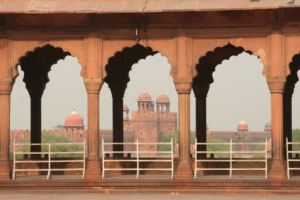INDIA’S CAPITAL CITY
 Delhi is the second largest city in India with a population of 15m. It is one of the major arrival destinations from overseas and is often regarded as a city from which to hurry away to start a holiday. However, undeniably noisy, dirty and a little intimidating to the first time visitor, it is a city (or more accurately a series of seven cities) brimming with history and culture and a day or two can easily be spent exploring its sites.
Delhi is the second largest city in India with a population of 15m. It is one of the major arrival destinations from overseas and is often regarded as a city from which to hurry away to start a holiday. However, undeniably noisy, dirty and a little intimidating to the first time visitor, it is a city (or more accurately a series of seven cities) brimming with history and culture and a day or two can easily be spent exploring its sites.
Places of Interest:
RED FORT (LAL QILA)
The red sandstone gives the fort its common name. It was commissioned by Shah Jahan in 1639 , took nine years to build and was the seat of Mughal power until 1857 when the last emperor was dethroned. It is worth exploring to imagine the sheer opulence enjoyed by the Mughal court. Every night, except Mondays, a sound and light show is held here starting after sunset and lasting about an hour (7.30pm winter, 8.30pm summer.) Bring mosquito repellent!
HUMAYUN’S TOMB
It is best photographed late afternoon for the most flattering light. It is Delhi’s oldest Mughal mausoleum and was built by the second Mughal Emperor, Humayun’s senior widow in 1565. It provides a little place of calm from the teeming streets outside. One of Delhi’s most beautiful historical sites. Don’t miss it.
JAMA MASJID
It is India’s largest mosque and as such should be treated with respect. Visitors are now given a voluminous spotted smock to wear to cover shoulders, arms and legs! Shoes must be removed at the door and a camera fee is charged. It is a very interesting place to people watch. It is worth climbing the tower ( a single lady must be accompanied by a man, like a guide) to get great views of the city.
QUTB MINAR
One of Delhi’s most famous landmarks, the 238ft high red sandstone tower of Qutb Minar towers over the complex. It was built between 1193 and 1369 to symbolise Islamic rule over Delhi and commemorate victory by Qutab-ud-din over the city’s last Hindu kingdom.
INDIA GATE
India Gate was built to commemorate the Indian and British soldiers who died in World War I and other wars. An eternal flame burns in memory of unknown soldiers who died in the 1971 Indo-Pakistan War. A nice place to chill out with a mango kulfi (ice cream) , in the company of Indian families on a warm summer evening.
RAJ GHAT
This is where Mahatma Gandhi was cremated the day after he was shot. There is a museum, Gandhi Memorial Museum which displays some of his photographs and letters.
BAHA’I TEMPLE
A stunning example of modern architecture, built in 1986. There are 27 giant white petals made of marble to symbolise an unfolding lotus flower. The gardens are well maintained and it is a place of great peace.
GANDHI SMRITI
A simple sandstone pillar marks the spot where Mahatama Gandhi was assassinated on 30th January 1948. The house, owned by the Birla family, has subsequently been turned into a museum commemorating his life.







